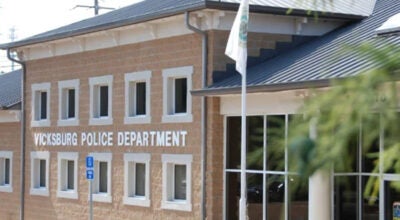Armenian by birth, American by choice, Keulegan a hero’
Published 12:00 am Monday, June 11, 2001
Emma Pauline Keulegan holds a photograph of her father, Garbis Keulegan, at her home in Vicksburg. (The Vicksburg Post/MELANIE DUNCAN)
[06/11/01] The news came to the young Armenian by Red Cross letter in 1919, right after diplomats had met in Versailles to try to end war forever.
The medics couldn’t say his family was dead, as their bodies were nowhere to be found in Sivas, the village where they had moved after he, their eldest son, left to complete his education in the United States in 1912. But to believe that his parents and four siblings still lived would be foolish, the letter told the Armenian. The human carnage, the Red Cross said, was complete.
And so Garbis Keulegan, who had left Armenia with nothing but his clothes and a plan to return to his family, never saw his homeland again. He would spend the rest of his 99 years in the United States, with not so much as a picture of his mother to comfort him on the nights when he’d wake up screaming, legions of Ottoman Turk soldiers marching through his dreams.
Keulegan never talked about what happened in Armenia with his only child, Emma Pauline Keulegan, not even in his last years as an engineer in Vicksburg. It was a secret he kept, lodged up there in his brain with the words from the seven languages he knew and the hydraulic equations he had to memorize to get his doctorate in physics at Johns Hopkins University in Baltimore in the 1920s. There were other secrets, too, especially after 1941.
“We always told him he could have worked for the CIA,” said his daughter, now a retired teacher in Vicksburg. “He was a very private person about everything.”
There was the suitcase that Keulegan always kept packed by the door of his home in Washington, D.C., where he had worked since 1920 for the National Bureau of Standards. There were the phone calls that came every few weeks, signals that soon a car would arrive Keulegan never got his driver’s license to take him away for a few days. He never talked about work. Eventually, Emma and his wife, Nellie, a seventh-generation Virginian who married the young immigrant in 1928, learned not to ask.
Emma Keulegan finally found out something about her father’s career in 1954, when he quit the Bureau of Standards to accept the position at Waterways Experiment Station he held until his death in 1989. Garbis Keulegan, she heard it said at his retirement ceremony, was a hero.
All those secret car trips during the early 1940s had ended on the New Jersey shore, where he had first helped the Army figure out where to land troops to fight the Germans in northern Africa. An expert on waves, Keulegan helped the Allies select landing sites in Algeria and Morocco.
Then, after Dwight Eisenhower and Bernard Montgomery had outdueled Nazi general Erwin Rommel in the Sahara, Keulegan and his fellow hydraulics experts turned their attention to the coast of northern France, where Adolf Hitler had erected his “Atlantic Wall” of armed forts, big guns and concrete bunkers to ward off the amphibious invasion he suspected the Allies were planning.
Keulegan and his Beach Erosion Board (BEB) colleagues William Christian Krumbein, Martin Mason and Morrough O’Brien helped the Army select the sites and date for the landing on the coast of Normandy that has become known as D-Day. An army of about 150,000 American, British, Canadian and French soldiers was supposed to hit Omaha, Utah, Gold, Juno and Sword beaches early on June 5. An Atlantic storm forced a one-day delay in the landing, though, making June 6 the most famous day in the history of American amphibious operations.
The brilliance of the plan forged by her father, his colleagues, and many other Allied scientists, Emma Keulegan said, has been demonstrated by D-Day casualty lists. American and British generals had estimated that 10,000 men would die storming the beaches. Fewer than 3,000 did.
“Tom Brokaw needs to know about him,” said Clyde Everett, a friend of the Keulegans’ since the 1960s, referring to the NBC newsman who has documented the lives of members of the World War II generation. “He’s a hero.”
But Emma said her father always blushed at praise, preferring to move from one success to more work. His hobby, his daughter said, was his job.
“He was a very modest man,” Emma Keulegan said as she sat in her living room last week, two days before the 57th anniversary of D-Day. “He would not like the fact that people are talking right now about what he did during the war.”
Keulegan, his daughter said, would rather people remember the greatness of the men he served in the Army, starting with Gen. John J. Pershing, the leader of the U.S. Expeditionary Force in World War I.
“He thought the sun rose and set with Pershing,” Emma Keulegan said. “The only general who ever came close to being as great as Pershing, he said, was (Douglas) MacArthur.”
Keulegan earned a spot on Pershing’s staff as a translator by virtue of his exceptional multilingualism he knew English, French, German, two forms of Armenian, Greek, Turkish and some Italian. He had put his graduate education in hydraulic physics on hold to serve with the Americans in World War I, and he immediately resumed his studies at Ohio State University after returning from the Western Front in 1918. He joined the Standards bureau in Washington in 1920, seeking a job with characteristic humility months after he realized he was in the United States to stay. “I applied for a low-grade position, but they would not accept me,” Keulegan said in a WES press release that marked his 60th year of government service in 1981. “They told me I was qualified for a higher grade, which I accepted.” At the same time he was employed by the Standards bureau, Keulegan worked toward his doctoral degree at Johns Hopkins’ Baltimore campus. He got the degree in 1928 and became a charter staff member of the bureau’s hydraulics lab four years later. It was from that position that the Army borrowed him during the war.
Because of her father’s taciturn demeanor, Emma Keulegan doesn’t know why he worked 68 years for the government of a country where he never planned to live. He never told her. But she thinks she can fill in the blanks left by his silence.
In Garbis Keulegan’s mind, she thinks, the United States was always the world’s guardian against the kind of atrocities that stranded him within its borders. And she thinks he must have had the genocidal Turks of Sivas somewhere in his mind when he was helping plan the assault that led to the fall of the Nazi authors of the Holocaust.
“He loved America so much, always flew the flag, always talked about what a great country it was,” she said. “He was more American than some Americans.”





